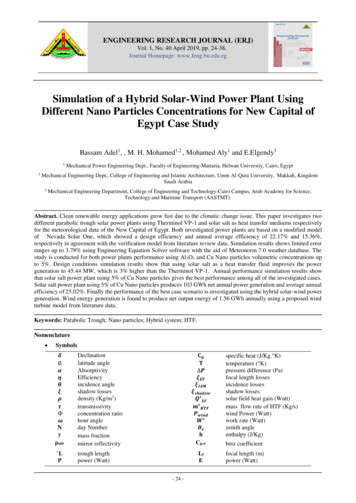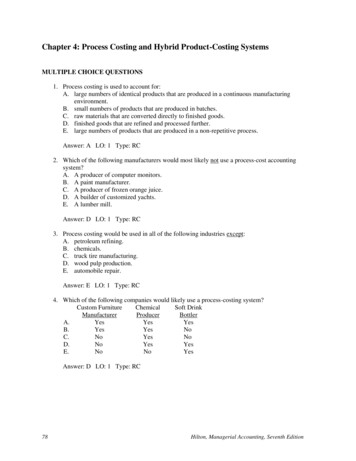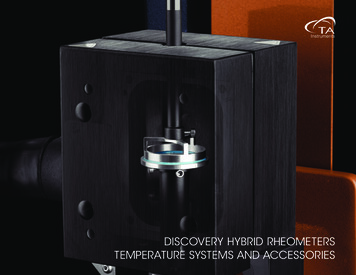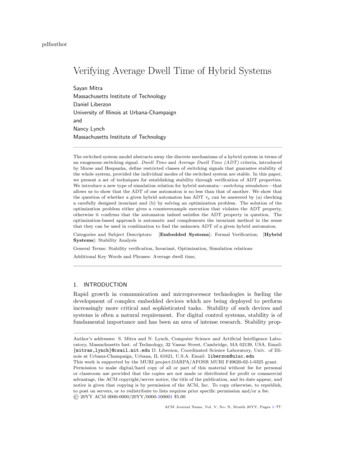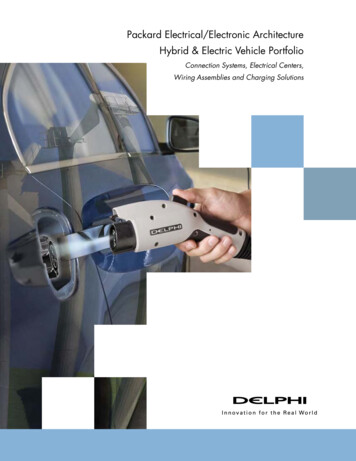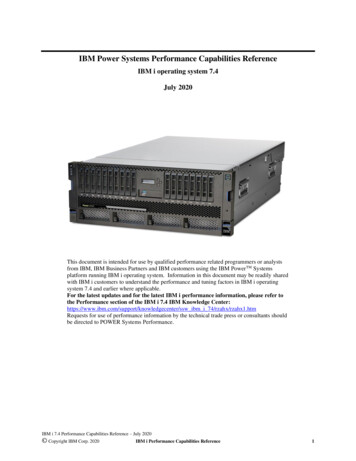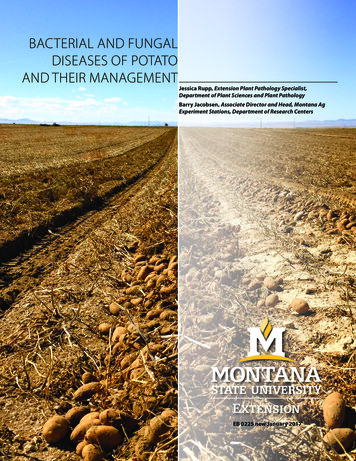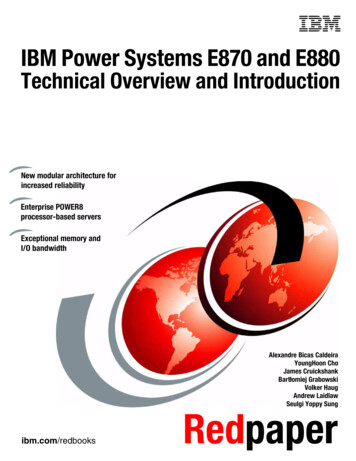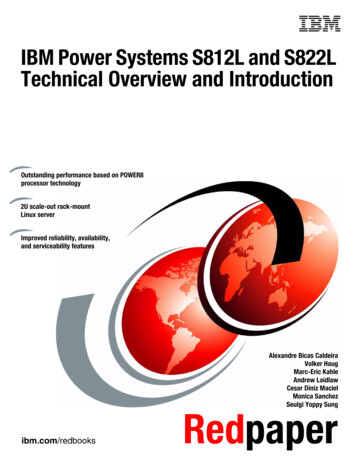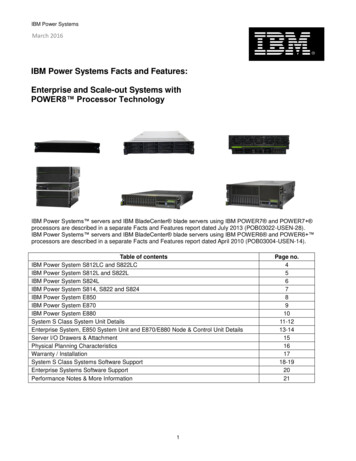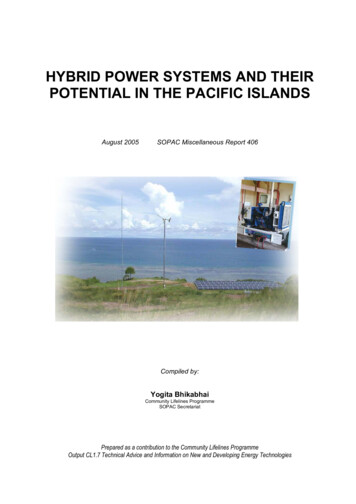
Transcription
HYBRID POWER SYSTEMS AND THEIRPOTENTIAL IN THE PACIFIC ISLANDSAugust 2005SOPAC Miscellaneous Report 406Compiled by:Yogita BhikabhaiCommunity Lifelines ProgrammeSOPAC SecretariatPrepared as a contribution to the Community Lifelines ProgrammeOutput CL1.7 Technical Advice and Information on New and Developing Energy Technologies
[2]ACKNOWLEDGEMENTSI would like to express my sincere thanks to the SOPAC Community Lifelines Programme forproviding resources for this paper. Special thanks to Mr Paul Fairbairn, Manager CommunityLifelines Programme and Mr Anare Matakiviti, Energy Adviser for their invaluable contribution andsupport.My heartfelt thanks to Mr Rupeni Mario, Energy Project Officer for his continuous guidance andsuggestions throughout the preparation of this paper; and to Emily McKenzie, SOPAC ResourceEconomist and Jan Cloin, Energy Adviser for their input and assistance.The Fiji Department of Energy is gratefully acknowledged for providing information resources andaccess to their library.Other resource personnel are thanked for their assistance and suggestions.[SOPAC Miscellaneous Report 406 – Bhikabhai (Compiler)]
[3]TABLE OF CONTENTSPageACKNOWLEDGEMENTS .2EXECUTIVE SUMMARY .5INTRODUCTION AND BACKGROUND .7WHAT IS A HYBRID POWER SYSTEM?.8COMPONENTS OF A HYBRID POWER SYSTEM .8PHOTOVOLTAICS .9WIND TURBINES .9BATTERY STORAGE .10BACK-UP GENERATORS .13INVERTERS.14CONTROL EQUIPMENT .17LOAD.19SYSTEM SIZING .19HYBRID POWER SYSTEM CONFIGURATION .25HYBRID POWER SYSTEM OPTIONS .26ADVANTAGES AND DISADVANTAGES OF HYBRID POWER SYSTEMS .28ECONOMIC ASPECTS OF HYBRID POWER SYSTEMS .29HYBRID POWER SYSTEM SIMULATION .31STEPS IN SUCCESSFUL HYBRID POWER SYSTEM IMPLEMENTATION.32POTENTIAL OF HYBRID POWER SYSTEM IN THE PACIFIC REGION .33EXAMPLES OF HYBRID POWER PROJECTS IN THE PACIFIC REGION .34Hybrid Power System at Nabouwalu, Fiji Islands.34Telikom PNG PV/Diesel Hybrid Power System.36CONCLUSION AND RECOMMENDATION.36RECOMMENDED READING LIST .38REFERENCES.38APPENDICES1 Glossary .402Hybrid Power System Simulation Example .42[SOPAC Miscellaneous Report 406 – Bhikabhai (Compiler)]
[4]LIST OF FIGURESPage12345678910111213141516171819Map of the Pacific region.6Components of Hybrid Power System .8Solar Panel.9Wind Turbine.9Constructional Features of a Lead Acid Battery.10Battery Cycle Life Vs DOD.11Correction Factor as a Function of Cell Operating Temperature .12Square Wave .15Modified Square Wave.15Sine Wave.15System Operation Vs Load .20Series Hybrid Power System .25Parallel Hybrid Power System.25Hybrid Power Sytem Options .26Parallel PV/Diesel Hybrid Power System .27Wind/PV Hybrid Power System.27Comparing Costs of Hybrid Power System vs others systems using LCC Analysis .30Steps in Hybrid Power System Implementation .32Nabouwalu Hybrid Power System .35LIST OF TABLESPage123Comparison of Average Daily Contribution from the Array to the Load .22Life Cycle Cost Comparison.30Wind Speed, Wind Energy Flux, and Daily Solar Radiation in the Pacific Region .33[SOPAC Miscellaneous Report 406 – Bhikabhai (Compiler)]
[5]EXECUTIVE SUMMARYThe Pacific island countries are blessed with a combination of naturally-occurring energy sourcesin the form of wind, sun or water. Wind turbines and solar photovoltaic cells are now beingpromoted as viable alternatives for power generation, either independently or in parallel withconventional generators. With fuel prices rising, the global concern of climate variability, climatechange and sea-level rise and a vision for sustainable development, hybrid power systemsestablished in the correct locations have become a good financial and economic option.In a hybrid power system, two or more types of generation sources are combined to produceelectricity. The most common generation sources for a hybrid power system are photovoltaic andwind turbines with a diesel generator as backup. The use of renewable power generationtechnologies reduces the use of imported fossil fuels, allowing for the cleaner generation ofelectrical power and optimisation of power supply options.Major components of a hybrid power system consist of renewable energy sources, internalcombustion engine, generators, battery storage and power conditioning equipment. For systemsizing, relevant information has to be gathered for the proposed location.This should include loadprofiles, supply area layout and resource assessment.Economic costs of hybrid power systems are determined by the system size, capital costs,operating costs, load profile, availability of technology in the country of use and the availability ofthe energy used to drive the system (fuel, solar insolation, wind, etc). Life Cycle Costing (LCC) isthe most common methodology for determining the cost effectiveness of energy alternatives.Careful planning and assessment is required to ensure the successful implementation of a hybridpower system. Training of operators, overseeing installation and commissioning, maintenanceprocedures and system monitoring and reporting are all part of the successful hybrid powersystem implementation process.Hybrid power systems have been commercially proven internationally, and are consideredsuitable for use in the Pacific region where the appropriate combination of renewable energyresources can be linked together with a standard traditional diesel fuel generation system. ThePacific region can benefit from the wide application of hybrid power systems.[SOPAC Miscellaneous Report 406 – Bhikabhai (Compiler)]
MAP OF THE PACIFIC REGION[6]Figure 1. Map of the Pacific Region[SOPAC Miscellaneous Report 406 – Bhikabhai (Compiler)]
[7]INTRODUCTION AND BACKGROUNDThis technical publication was prepared with the view to increasing Pacific Island membercountry1 awareness on hybrid power systems and to enable them to make informed decisions. Atthe Regional Energy Meeting (REM2000) held in Tarawa, Kiribati in 2000, a request was madefor technical briefing papers on new and upcoming technologies. The SOPAC CommunityLifelines Programme2 offered to coordinate the preparation of three technical briefing papers.Since then four technical papers have been prepared, published and circulated to membercountries for information. These include Hydrogen Fuel Cell and the Pacific Islands, Space SolarPower Generation and the Pacific Islands, Ocean Thermal Energy Conversion and the PacificIslands and Geothermal Energy Utilisation and the Pacific Islands.This technical publication, Hybrid Power Systems and Their Potential in the Pacific Islands aimsto give its readers a better understanding of hybrid power systems. The publication details thebasic components of a hybrid power system, how it operates, the economic aspects,appropriateness to the region and steps in successful implementation of a hybrid power systemproject. For those readers who do not have technical background, a glossary of terms has beenincorporated in Appendix 1 of this publication.It is becoming more and more apparent in the world of renewable energy that systemspecification and site location choices are crucial to a high quality of service at lowest capitalcosts. A hybrid power system becomes an attractive option where there are opportunities toprovide power generation with optimum efficiency through the combination of traditional andrenewable energy sources.Hybrid power systems usually integrate renewable energy sources with fossil fuel generators(diesel/petrol) to provide electrical power. They are generally independent of large centralizedelectric grids and are used in remote areas. In these systems it is possible for the individualpower sources to provide different percentages of the total load. For instance, on a cloudy windyday when the solar panels are producing low levels of electricity, the wind generator compensatesby producing a lot of electricity. Naturally, to use a wind generator effectively requires a locationwith a good wind regime. Balancing the power sources to achieve the highest level of systemperformance takes thorough research. Resource assessment and location must be assessed todetermine sizing for optimised performance.1 SOPAC island member countries are American Samoa (Associate), Cook Islands, FSM, Fiji, Guam, Kiribati, Marshall Islands, Nauru, Niue,Palau, Papua New Guinea, Samoa, Solomon Islands, Tonga, Tuvalu, Vanuatu, French Polynesia (Associate), New Caledonia (Associate)2The SOPAC Energy Unit is now part of the Community Lifelines Programme following the latest corporate restructure (2001)[SOPAC Miscellaneous Report 406 – Bhikabhai (Compiler)]
[8]WHAT IS A HYBRID POWER SYSTEM?Hybrid power systems generally integrate renewable energy sources with fossil fuel powereddiesel generator to provide electric power where the electricity is either fed directly into the grid orto batteries for energy storage. The role of integrating renewable energy in a hybrid power systemis primarily to save diesel fuel.There are generally two accepted hybrid power system configurations: Systems based mainly on diesel generators with renewable energy used for reducing fuelconsumption; and Systems relying on the renewable energy source with a diesel generator used as a backup supply for extended periods of low renewable energy input or high load demand.COMPONENTS OF HYBRID POWER SYSTEMA typical hybrid power system (Figure 2) may contain a combination of: Renewable energy sources (solar / photovoltaic, wind turbines, micro hydro, biomass); Internal combustion generators (eg. diesel engine); Battery storage; and Power conditioning equipment (inverter, battery charge regulator).Energy from the sun isconverted to DirectCurrent (DC) electricalenergy.Electromagneticdevice for convertingmechanical energy intoelectrical energyDirect Current (DC)is changed
Hybrid Power System at Nabouwalu, Fiji Islands.34 Telikom PNG PV/Diesel Hybrid Power System.36 CONCLUSION AND RECOMMENDATION.36 RECOMMENDED READING LIST.38 REFERENCES.38 APPENDICES 1 Glossary.40 2 Hybrid Power System Simulation Example.42 [4] [SOPAC Miscellaneous Report 406 – Bhikabhai (Compiler)] LIST OF FIGURES Page 1 Map of the
